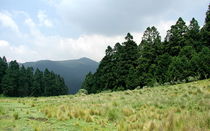
Sacred fir
It is a medium-sized to large evergreen coniferous tree growing to 2550 m tall with a trunk diameter of up to 2 metres . The leaves are needle-like, flattened, 1.53.5 cm long and 1.5 mm wide by 0.5 mm thick, dark green above, and with two blue-white bands of stomata below; the leaf apex is acute. The leaf arrangement is spiral on the shoot, but with each leaf variably twisted at the base so they lie flat to either side of and above the shoot, with none below the shoot. The shoots are reddish-brown, hairless or with scattered pubescense. The cones are 816 cm long and 46 cm broad, dark blue-purple before maturity; the scale bracts are purple or greenish, of moderate length, with the tips exposed in the closed cone. The winged seeds are released when the cones disintegrate at maturity about 79 months after pollination. Trees from the western end of the range on Nevado de Colima, Jalisco have cones with larger, reflexed bract scales ; these are sometimes treated as a separate species, Abies coStands of Abies religiosa provide winter habitat for the Monarch butterfly. A Project Lighthawk documentary provides a useful summary HERE (or, en Espaρol. These stands are being depleted by logging, threatening the continued survival of the butterfly. As of 2007, the logging continues even though much of the area involved has been protected (as detailed in the preceding link), and the phenomenon has become such a popular ecotourism attraction that it provides a significant income to communities near these forests. More
For more multimedia, look at Abies religiosa on Wikimedia Commons. Retrieved from "http://species.wikimedia. More
